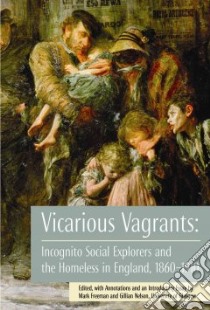Vicarious Vagrants - 9780979111624
Un libro in lingua di Freeman Mark (EDT) Nelson Gillian (EDT) edito da The True Bill Pr, 2008
- € 52.60
- Il prezzo è variabile in funzione del cambio della valuta d’origine
When the novelist Jack London went in disguise among the poor of the East End, he remarked: “For the first time I met the English lower classes face to face, and knew them for what they were.” The period covered by this book was the heyday of the incognito social explorer. Many men and women travelled in disguise among the poor in England and published lively accounts of their experiences. The most common social group investigated in this way were the homeless, and this book reprints several accounts of incognito investigations of vagrancy. Many found themselves in the workhouse casual ward, or “spike;” others in common lodging-houses; and some on the open road. Their descriptions of the conditions in which vagrants, or tramps, lived, and of the many engaging characters that they met, vividly convey the tenor of life among the Victorian and Edwardian “underclass,” or the “submerged tenth,” as they were designated by William Booth. This book reprints several examples of the genre, beginning with James Greenwood's classic account of a night in Lambeth workhouse in 1866, published under the pseudonym “The Amateur Casual.” Other documents included in this edited collection are less well-known, and have never before been reprinted, such as C. W. Craven's description of a night in Keighley workhouse in Yorkshire in 1883, and George Z. Edwards's Vicar as Vagrant, dating from 1910. Three longer pieces are also included: J. H. Stallard's The Female Casual and Her Lodging (1866), for which a working-class woman was sent undercover to investigate the metropolitan casual ward system; Greenwood's On Tramp, an account of the author's experiences as a vagrant in rural Hertfordshire in 1883; and Everard Wyrall's The Spike (1909), which describes various institutions for the relief of the homeless in and around London, and illustrates the difficulties that many social explorers had in maintaining their disguise. The book also contains a description of the “spike” in Burnley, Lancashire, by the socialist pamphleteer J. R. Widdup; an article by Mary Higgs, the wife of a Congregationalist minister about a women's casual ward; an article from the Gentleman's Magazine describing a night in a London casual ward in 1883; and a versified account of Greenwood's iconic night in Lambeth in 1866. The editors' introduction sets the documents in the context of legislative responses to vagrancy, especially the development of the poor law in nineteenth- and early twentieth-century England. Vagrancy law has a long history: legislation as early as the fourteenth century attempted to control the movement of laborers around the country, and, in the early modern period, harsh measures were devised to deal with vagrants, including floggings and imprisonment in “houses of correction.” The Vagrancy Act of 1824 introduced new penalties, while in the early nineteenth century philanthropists made more efforts to help the destitute. However, the period covered by this book saw the number of vagrants in England increase tenfold, and a new set of policy responses emerged. The construction of workhouse casual wards, and harsher penalties for “undeserving” vagrants, represented a hardening of official attitudes, although sympathy abounded for the “deserving” poor, who became homeless through no fault of their own, and for whom help, rather than punishment, was deemed appropriate. The distinction between “deserving” and “undeserving” is pervasive in the texts that are reprinted in this book, and the editors trace the long history of the distinction, as well as the specific policy proposals of the late Victorian and Edwardian era. For example, many of the vicarious vagrants proposed labor colonies, to remove the “habitual” tramps from society, and to prevent them from contaminating their unfortunate, “deserving” counterparts. Although few labor colonies were ever actually established, they found widespread support across the political spectrum, including the emergent Labour Party. The editors also relate vicarious vagrancy to the emergence of new social research methods in this period. The “scientific” social survey, epitomized by Charles Booth and Seebohm Rowntree, contrasted with the impressionistic accounts of undercover social explorers. It would have been easy to relegate vicarious vagrancy to an inferior stratum of social investigation. However, the editors show that contemporaries did not draw a rigid distinction between quantitative social surveys and the more descriptive accounts of poverty that remained an important feature of the social investigation of the period. Undercover exploration was particularly important where the group under investigation – in this case, vagrants – was not easily accessible using more direct methods of social research. The texts in this book may have been full of dramatic intensity, but they also served a useful social and political purpose. Moreover, it is possible to see the vicarious vagrants of this period as forerunners of modern incognito social investigators, many of whom can be found in print, and in other media, today. The vicarious vagrants were aware of the methodological and ethical difficulties that beset their work, and although they did not couch these difficulties in the language of modern sociological participant observation, they encountered the same barriers to social understanding that social researchers encounter today. The editors' introduction assesses the texts in the light of these methodological issues, and assesses their value, to contemporaries and to historians. The texts themselves are annotated, and there is a full index.
Informazioni bibliografiche
- Titolo del Libro in lingua: Vicarious Vagrants
- Sottotitolo: Incognito Social Explorers and the Homeless in England, 1860-1910
- Lingua: English
- Autori : Freeman Mark (EDT) Nelson Gillian (EDT)
- Editore: The True Bill Pr
- Collana: The True Bill Pr (Hardcover)
- Data di Pubblicazione: 01 Novembre '08
- Genere: HISTORY
- Pagine: 327
- Dimensioni mm: 228 x 158 x 25
- ISBN-10: 0979111625
- EAN-13: 9780979111624


